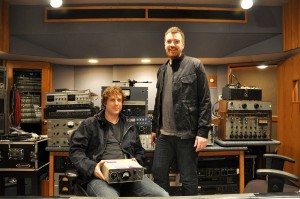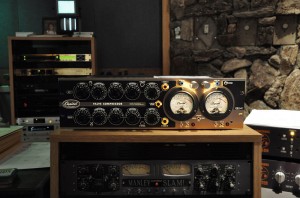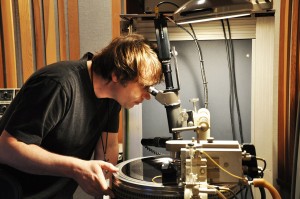Shop Talk: Rock Frontman Turned Capitol Tech, Ian Sefchick
HOLLYWOOD: With the right mix of ambition and creativity, a true do it yourselfer will be unstoppable. And Ian Sefchick is a true do it yourselfer.
From serving as front man, singer and guitar player in ‘90s alt rock band, Creeper Lagoon to a tech at legendary Capitol Studios, Sefchick is constantly creating. Leaving touring behind to take a job at Apex, the curious electronics junkyard haven in the San Fernando valley, Sefchick developed a unique knowledge base and skill-set that today makes him a sought after gear designer. Now, his creative evolution has brought him to yet another chapter in his career… cutting vinyl.
Catching up with Ian in the tech shop at the Capitol tower, we were able to get the story from the beginning.
When did your fascination with electronics begin?
I was really young; as soon as I was old enough to use a screwdriver I was taking apart my Christmas toys, remote control cars or whatever I could to see how they worked.
Did that come before music?
It definitely came before music. Where I grew up in Ohio, I was really into go-carts, mini bikes and taking apart engines. When I was twelve, thirteen years old that’s all I wanted to do… ride mini bikes and build gas engines… more mechanical things… and then into my early teenage years I got into music and then building guitar amplifiers. I would tear apart old record players, the old wood consoles, and take the little 6V6 tube amps out of them.

Ian Sefchick and engineer/mixer Greg Koller (Jon Brion, Of Montreal, Spoon) at Capitol. Photo by Cian Riordan.
Back then the Groove Tubes amp book had just come out, it had all the schematics of these amplifiers. I just studied that book with the help of a college student who did repairs for the local music shop. He showed me how to build amps out of these old consoles. I built a Champ, then a Marshall, it just went from there. Then I started making my own amps.
Audio was with me alongside being in bands, and moving to the west coast. And then my music career started. After recording with Creeper Lagoon in different studios like The Plant in Sausalito, Can Am, Cherokee and Sony, I started to get more into pro audio stuff. With the help of the DIY internet craze I taught myself how to build mic pres and compressors.
Eventually you ended up at Apex. How did that happen?
I was a customer there while building equipment for a band I was in called, “On the Speakers” for recording our record. But first, I found out about it while working at Line 6 doing product testing. Apex had all types of exotic vintage tubes, switches and transformers… everything I could ever want to build the stuff I was learning about on the internet.
I worked there for four years, during that time a lot of techs came in from the studios… I met them and I would learn from them. Primarily Fred Bova, who was the chief tech at A&M, taught me a lot just over the counter selling resistors and capacitors. Then I heard there was an opening at Capitol.
And how long have you been at Capitol?
I’ve been here for three years now. [Awhile back], Greg Koller and Jon Brion came in and we clicked instantly – they had a really deep sense of sound and that helped me a lot. There are different levels to building gear… You can easily put together a pre amp and a power amp or change tubes out of pre amps and get a different sound. Sound is so subjective and it’s easy these days to throw anything together circuit-wise and get a cool sound. Then there’s another level: when you add up gear in a whole mix… a whole production.
Jon and Greg are really good at selecting a totality of gear that all works in harmony, has a certain fidelity. Each piece alone may sound special or not, but added up it sounds very special. It’s extraordinary, the kinds of mixes they do. And they taught me how to listen. I would say the frequency response is great on something I did, I checked it on the AP, the distortion is low… this has to be cool, then Koller would say, “No, do you hear that? The peakyness in the midrange?” At first I didn’t know what he was talking about, but after awhile I started understanding what they were hearing and started building things looking for that sound.
So Greg and Jon have been big influences on you… is there anyone in particular, at any point in your career, that has been the most influential?
In every aspect of music, production and engineering, to me, as an adult they have really been the most influential. As a kid in a band, my only other influences were other bands. I didn’t know about the world of production. I feel really lucky that they came here.
You’ve been designing gear for Capitol, too, yes?
I had a prototype of this compressor I had been working on for a long time. I brought it in and let Bob Vosgien use it. He really liked it and helped me refine it as far as gain structuring and such. After that, they gave me a budget to make it.
I built four including the prototype and now all the mastering engineers have one. Niko Bolas has the prototype… he likes to use it for tracking.
And now you’ve started cutting vinyl. Tell us about that.
One of the techs that worked on the lathe retired leaving only one other who’s close to retiring, that can maintain it. So I decided I needed to learn, nobody else was taking an interest.
To learn how to work on it, I needed to learn how to use it. When I was starting, I asked Ron McMaster, who cuts vinyl here at Capitol, to show me how to run it. It just happened to be that he was mastering LeAnn Rimes’ album, which is not out yet.
We used a really cool method; we took the mix, ran the lathe at 45 speed with the lines per inch all the way open, basically the highest resolution it could do, cut the song on vinyl, then played that back into the computer. We did that with each song and everybody loved it. That was basically the mastering process for that record, which was actually Niko’s idea.
So that got me started, because we had to cut a lot, every song had to have a new lacquer. Then Greg had me mess around with some stuff he was working on… I just took a liking to it. I just cut the new Gold Fields record, hopefully I have more of this in my future.
So are you available to cut vinyl for people now?
Hells yeah! I can be contacted through Capitol Mastering. There’s a lathe in storage as well and they’re going to set up a cutting room for me.
Thanks, Ian. How would you like to wrap this up?
From musician to cutting vinyl and everything in between, you can do anything in any aspect of music. There are so many avenues to branch into. Don’t let your ego trap you into thinking your identity is any one thing you are doing. As you grow, let your job grow with you.
Email Ian Sefchick at ghostbabymusic@gmail.com.
Michael Westbrook is a studio technician in Los Angeles specializing in building custom and unusual mixing consoles.
Please note: When you buy products through links on this page, we may earn an affiliate commission.








